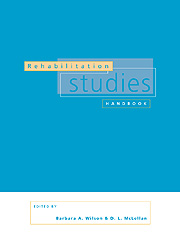Book contents
- Frontmatter
- Contents
- List of contributors
- 1 Introduction to rehabilitation
- 2 Disabled people in society
- 3 Disability equality training
- 4 Towards a therapeutic alliance model of rehabilitation
- 5 Rehabilitation education: a learner-centred approach
- 6 Work, occupation and disability
- 7 Management in rehabilitation
- 8 Research and evaluation in rehabilitation
- 9 Statistical methods
- 10 Social policy, disability and rehabilitation
- 11 Principles of the acquisition of sensorimotor skills
- 12 Management of acquired cognitive disorders
- 13 Challenging behaviour: helping people with severe brain damage
- 14 Pain
- 15 The multiply handicapped child
- 16 The transition to adult life
- 17 Factors specific to disabled elderly people
- Index
4 - Towards a therapeutic alliance model of rehabilitation
Published online by Cambridge University Press: 06 November 2009
- Frontmatter
- Contents
- List of contributors
- 1 Introduction to rehabilitation
- 2 Disabled people in society
- 3 Disability equality training
- 4 Towards a therapeutic alliance model of rehabilitation
- 5 Rehabilitation education: a learner-centred approach
- 6 Work, occupation and disability
- 7 Management in rehabilitation
- 8 Research and evaluation in rehabilitation
- 9 Statistical methods
- 10 Social policy, disability and rehabilitation
- 11 Principles of the acquisition of sensorimotor skills
- 12 Management of acquired cognitive disorders
- 13 Challenging behaviour: helping people with severe brain damage
- 14 Pain
- 15 The multiply handicapped child
- 16 The transition to adult life
- 17 Factors specific to disabled elderly people
- Index
Summary
In this chapter, the descriptor ‘patient’ is used rather than ‘client’. This follows the convention adopted by Davis & Fallowfield (1990) when they speak of the inappropriate consumerist flavour of the word, and its derivation from ‘cliens’ meaning ‘dependent, client, adherent, follower or vassal’. While ‘patient’ may not be ideal either, it does at least carry the connotations of perseverance, forbearance and endurance, all of which are valuable qualities in the field of rehabilitation.
In recent years, the patterns of disease and disorder in industrialised nations have changed, with the balance moving away from acute infective diseases and towards more chronic conditions, many of which have environmental and/or behavioural causal factors. Changes in the pattern of health care have therefore become necessary, with the emphasis on long-term management rather than on short-term medical intervention, and on coping, adjustment and management rather than cure in many cases.
These issues invite consideration of the psychosocial aspects of health care, and in particular the question of whether patients and health care professionals (HCPs) have a common language, a common way of understanding and dealing with the issues of health and illness, and common expectations of processes and outcomes. Where there are differences rather than commonalities, they invite a consideration of the status of patients' perspectives, and ways of dealing with fears and with unrealistic expectations of therapy. They invite a consideration of patients' and HCPs' coping strategies, and the conditions under which they are facilitated or break down. They invite a look at commitment to staying the same and commitment to change, for HCPs and patients alike.
- Type
- Chapter
- Information
- Rehabilitation Studies Handbook , pp. 75 - 94Publisher: Cambridge University PressPrint publication year: 1997
- 3
- Cited by



